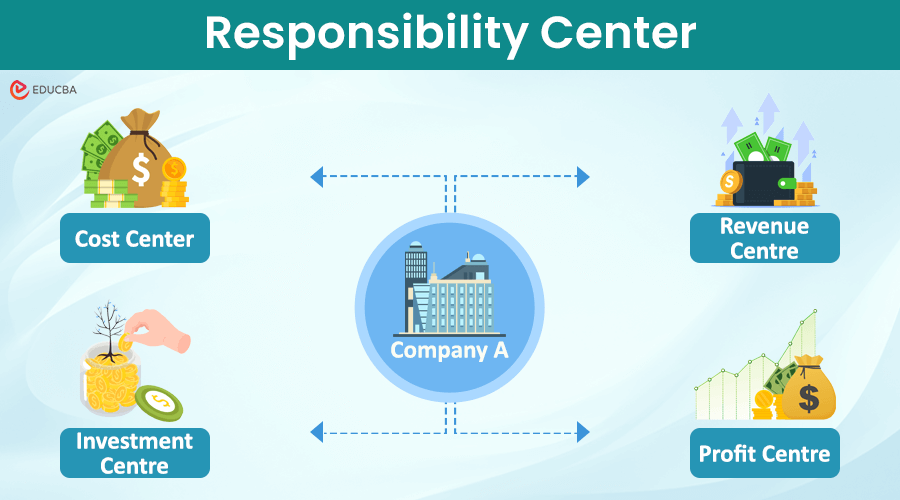What is Responsibility Center?
The term “responsibility center” refers to the operational units within an organization that are accountable for the activities specially designed for them.
These units usually have their staff, goals & objectives, and policies & procedures. These units also manage matters related to revenue generated, expenses incurred, and funds invested in their activities. This arrangement is usually seen in large multinational companies, where the organizational tasks are divided into multiple subtasks. The responsibility centers assign each task to a small division or group.

Key Takeaways
Some of the key takeaways of the article are:
- The responsibility center refers to the operational units within an organization that have well-defined individual targets to fulfill and are accountable for them.
- Large organizations usually divide their work into smaller subgroups so that every unit achieves its goals that all add up to fulfill the overall organizational objectives.
- These units have their staff, goals & objectives, and policies & procedures.
- There are four significant types of responsibility centers – cost center, revenue center, profit center, and investment center.
How does Responsibility Center work?
In a large organization, all the tasks are split amongst smaller teams focusing on their respective objectives. These small units work synchronously to achieve the overall organizational goals.
Each unit has its targets and goals, which they are expected to achieve within a pre-defined timeline. These subgroups use their resources, follow procedures, prepare financial reports, and bear responsibilities. Although they function independently, they tend to contribute toward the common organizational objective.
Types of Responsibility Center
There are four significant types of responsibility centers – cost center, revenue center, profit center, and investment center.
1. Cost Center
It is a unit that allocates, supervises, segregates, and eliminates different kinds of cost-related issues of a company. The primary responsibility of a cost center is to manage the company’s costs and check its unwanted expenditures. Under the cost center, the manager is responsible for all expenses, including maintenance, production, HR, etc.
2. Revenue Centre
It is accountable for generating and monitoring revenue. The management has hardly anything to do with control over cost or investment-related issues within the organization. Comparing the budgeted revenue with the actual payment determines the performance of the revenue center.
3. Profit Centre
It is a division within an organization that functions to maintain profit margins. So, it is no wonder that the profit center manager is responsible for costs and revenues. The manager needs to look after matters and decide price and production decisions.
4. Investment Centre
It is primarily responsible for investment-related of the organization. The manager may need to control income and expenses in order to manage profitability, which they eventually invest in other assets.
Examples of Responsibility Center
Let us look at a simple example to decipher the role of the responsibility centers within an organization.
ABC Inc. manufactures a range of denim wear, such as pants, shirts, tops, etc. The company often invests huge capital to carry out large business operations or expand. And like any other business, it manufactures goods and sells them in the market, generating revenue.
Hunting for the best investment choice is not the same as looking for a profitable market. The former analyzes return on investment, while the latter intends to maximize profit. Large organizations subdivide tasks into small units or groups.
Here, a unit dedicatedly looks into investment-related matters while another team identifies the target market for maximum profit. It can be seen that each group has a different type of responsibility.
Importance of Responsibility Center
The process of creating responsibility centers helps an organization achieve its overall goals. In this arrangement, the tasks are segregated and tagged to many managers, allowing proper delegation and control. Without responsibility centers, it will be difficult for organizations, huge multinational companies, to manage their operations and achieve their overall organizational goals and objectives. This is because these units with an organization are analogous to the different parts of the human body.
Advantages of Responsibility Center
The following are the significant advantages of the responsibility center:
- First, given that there is a responsibility assigned to all the units, each individual has responsibilities aligned with the roles that direct them toward a common purpose.
- Since senior management tracks and reports individual performances, each individual tends to give their best performance.
- It facilitates better delegation and control of organizational tasks, which is one of the objectives of management.
Disadvantages of Responsibility Center
The following are the significant disadvantages of responsibility center:
- First, a conflict of interest may arise between the individual objectives and the organizational goals.
- The management must invest a lot of time and effort to plan and meticulously chalk out the course of action.
- Sometimes, the employees or managers are resistant/ reluctant to join a particular department/ segment/ role.
Conclusion
So, it can be seen that responsibility centers are essential cogs in any organizational machinery. It can help organizations grow and seamlessly manage their activities if implemented correctly and efficiently.
Recommended Articles
This is a guide to Responsibility Center. Here we also discuss the definition, working, types, examples, and importance, along with advantages and disadvantages. You may also have a look at the following articles to learn more –

